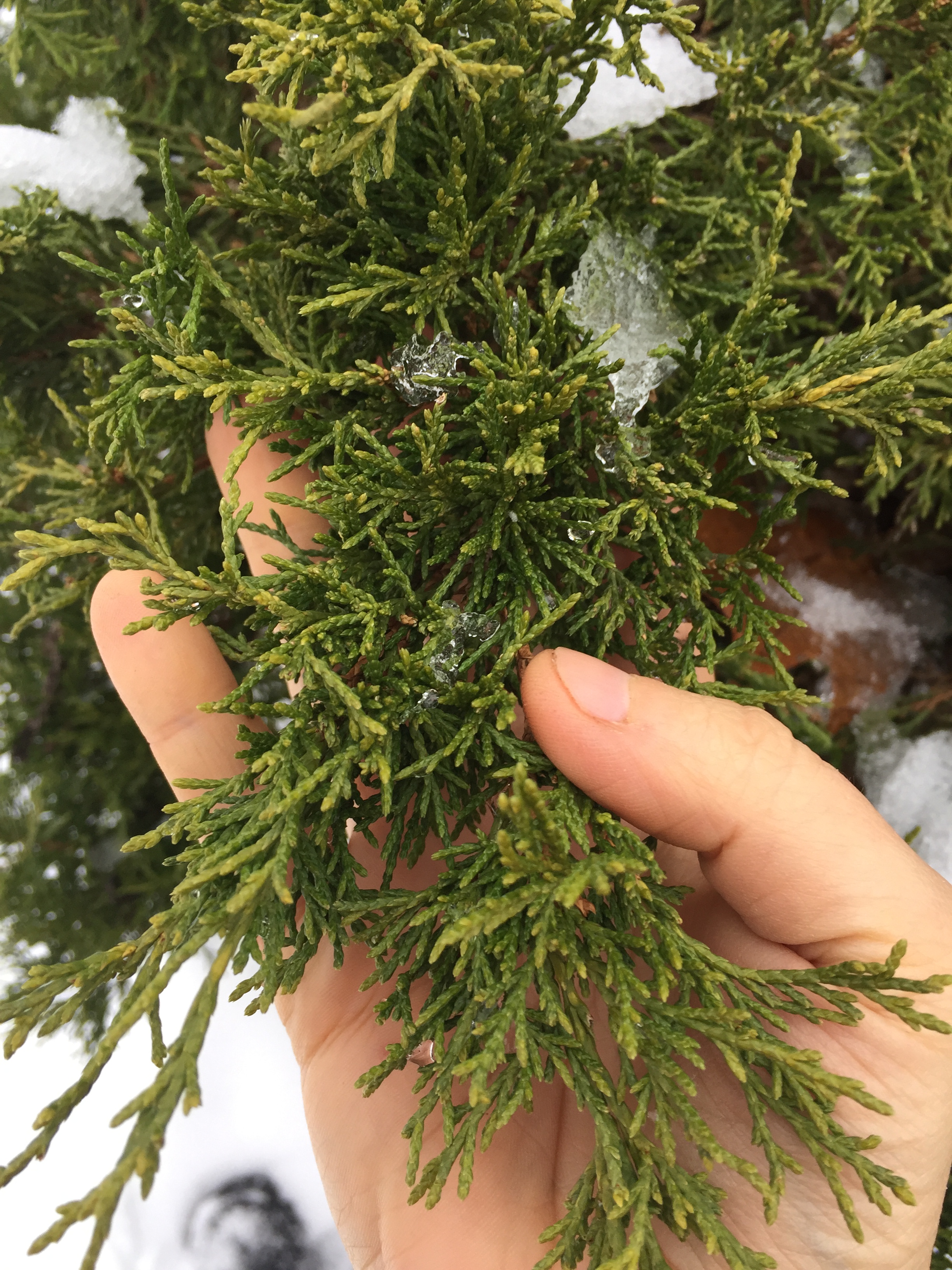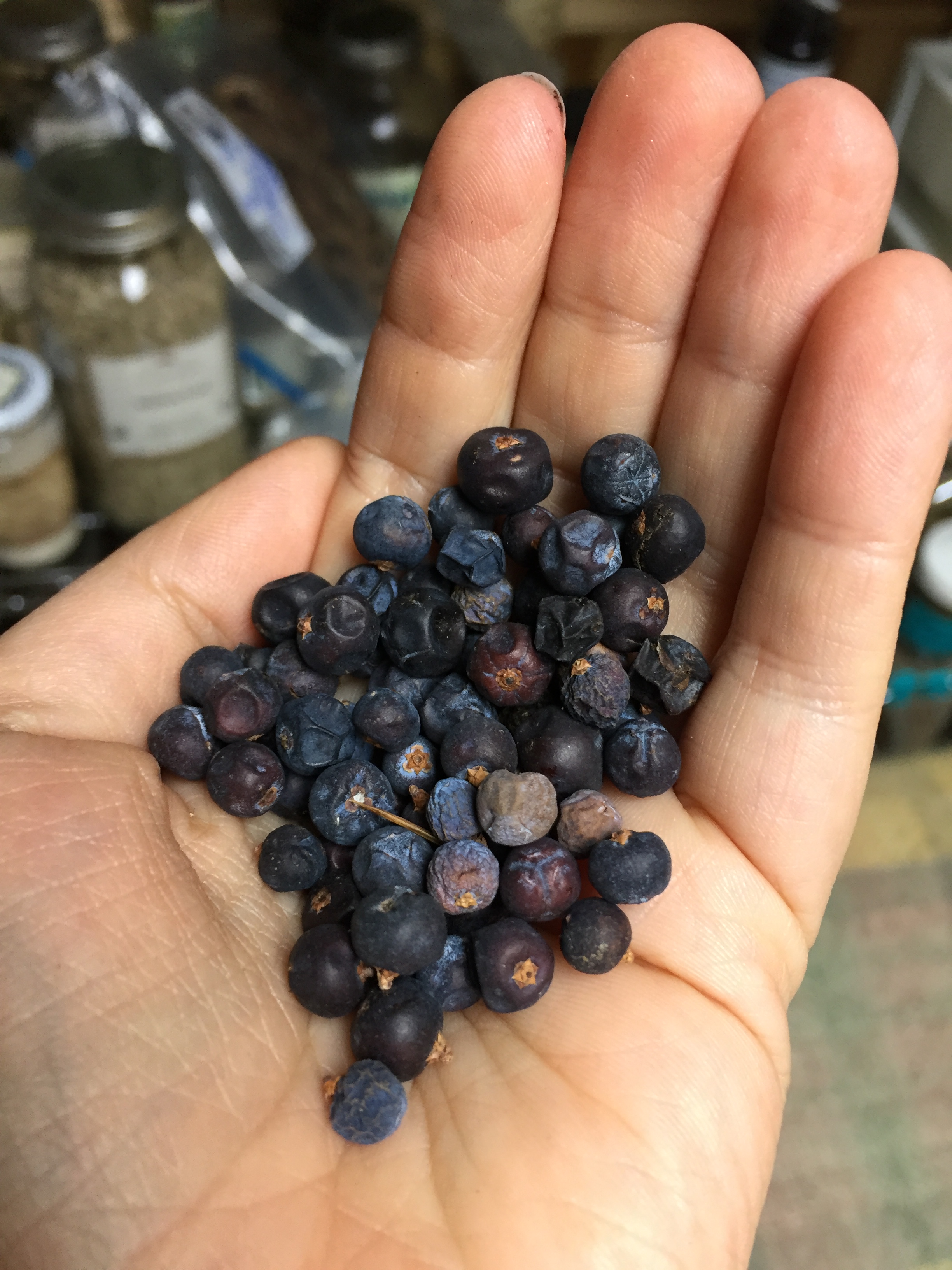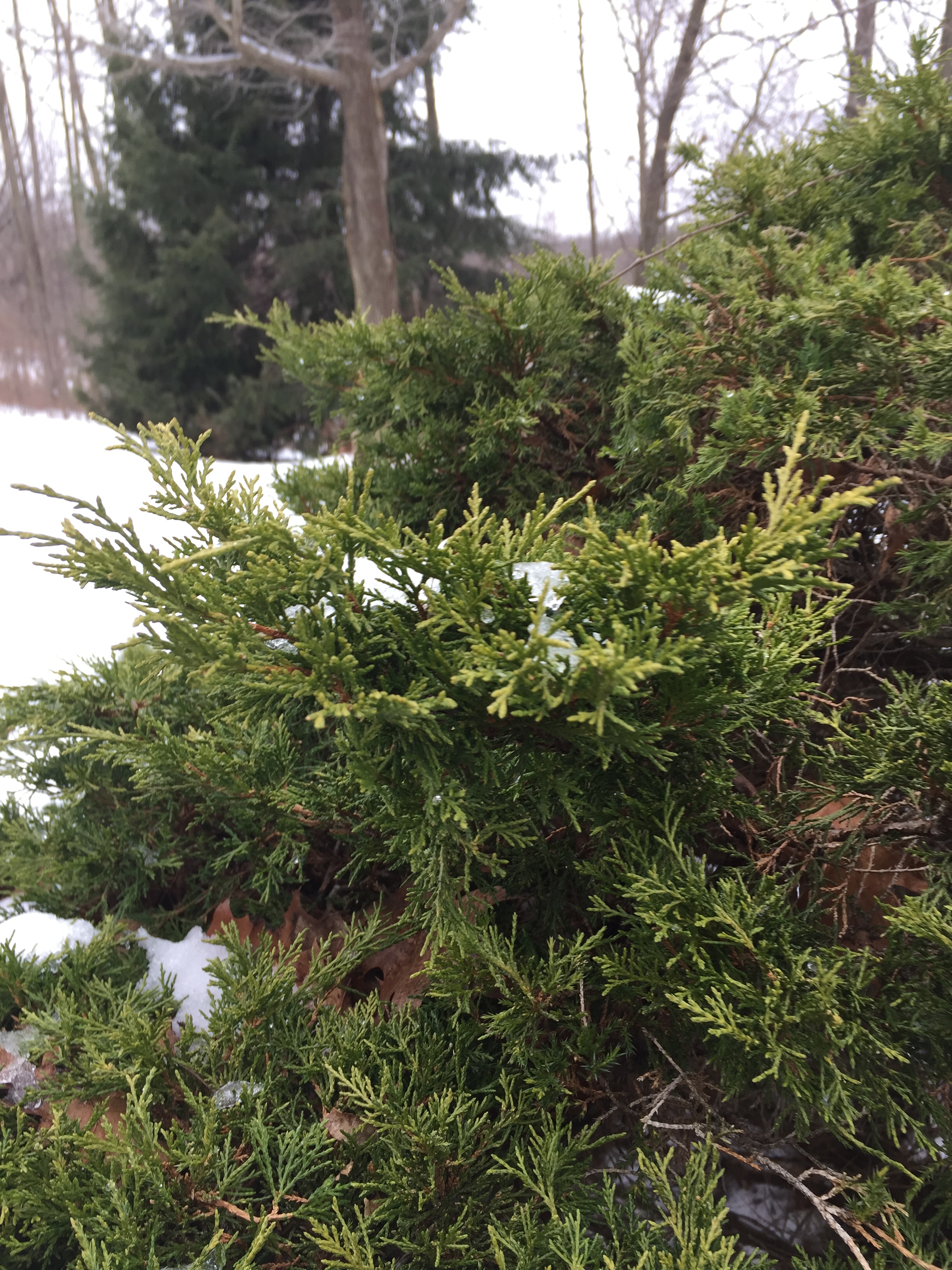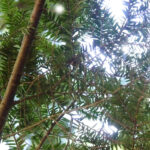Here on the East Coast of the USA, we are still in deep winter. Soon, the maples will be flowing. Soon, the winter snows will melt. Soon, spring will return. But until that time, the conifers, particularly offer strength and wisdom. One of my favorite conifers is Juniper, also known as Eastern Red Cedar. It is delightful to come across a wild juniper in the winter months, with her sweet and pine-scented berries and her delightful sprigs that offer friendship and hope through the darkest times. So come with me today as we explore the sacred Juniper tree.

This post is part of my Sacred Trees in the Americas series, where I explore sacred trees within a specifically American context, drawing upon folklore, herbalism, magic, and more! I think it’s particularly important that US druids and those following other nature-based paths in North America understand how the trees here might be different and just as magical as traditional European trees. So this series does just that–providing research and insight on the many trees here in the US East Coast. Previous trees in this series include Birch, Elder, Walnut, Eastern White Cedar, Hemlock, Sugar Maple, Hawthorn, Hickory, Beech, Ash, White Pine, and Oak. Let’s delve into the magic, medicine, and mythology of the Juniper tree!
Description
In Eastern North America, our dominant Juniper variety is Juniperus virginiana, also known as Eastern Red Cedar. Other names for Juniper include red juniper, baton rouge, pencil cedar, savin, or just cedar. Despite being called a Cedar, Juniper is actually in the cypress family, offering different kinds of needles (which are technically leaves)-very sharp, pointed, and prickly when they are young, and flattened, scale like, and overlapping as they age. These older needles are reminiscent of Eastern White Cedar, perhaps this is why the two are sometimes both called cedar.
According to John Eastman, Juniper is a long and slow growing tree. It can live 200-300 years, and prefers open fields and other sunny locations. Junipers can produce cones starting between age 10 and age 25; some trees bear female cones and other trees bear male cones and the cones are wind pollinated. The tree is not very shade tolerant, so needs the sun in order to thrive. According to Grimm, Junipers can grow up to 30-40 feet high with a trunk diameter of 1-2 feet. I don’t think I’ve ever seen a Juniper that large here in PA, as it is often instead found on dry or rocky soils, on limestone outcroppings or soils, and in abandoned fields. Unlike many conifers, Juniper cannot handle fire and can’t rehabilitate or re-establish after fire-burned sites. However, Juniper is great at helping repopulate what are often called “wastelands” – overfarmed and abandoned fields, old gravel pits, and the like. At a distance, the Juniper tree looks like a flame, blazing up on the landscape–they are easy to spot and since they are conifers, they stay green year-round.
In the summer, you might come across a Juniper that looks more like an alien, with strange orange tentacles coming out of it everywhere! I remember the first time I saw this and I had no idea what i was seeing! Turns out it is the Cedar apple fungi (G. Juniperi-virginianae), which is largely harmless to the Juniper but which infect apple and hawthorn trees with a gymnosporagium rust. The rust is very detrimental to harvests of both apple and hawthorn, meaning that many who have orchards prefer to cut Junipers down rather than let them grow and possibly carry the rust. You can tell whether or not a Juniper is infected with the rust–it will have large brown galls on it on the outer branches that have small holes within them, almost looking like potholes all over the gall. The orange alien-like tentacles come out of the nodules to spread the rust once a year–quite a sight to behold!

Juniper produces leaf litter that is high in calcium, creating slightly alkali soil (as compared to most conifers, whose leaf litter produces a more acidic soil). Because of the increase in calcium, it is also an excellent place to find earthworms if, say, you wanted to go fishing. Here in Western PA, we have particularly acidic soil, almost too acidic, so juniper leaf litter is very useful for helping bring the acidity back into balance.
Further, almost 90 different birds feed on the fruit of Juniper, Birds help disperse the seeds, which require cold stratification to sprout. Others who eat the delicious fruit include chipmunks, mice, and opossums, voles, coyotes, red squirrels, and foxes. In the late winter, you will often see multiple species feeding on a juniper tree when there is little else to be found!
Regenerating Damaged Landscapes
Juniper is quite good at growing in thin or depleted soils, or soils that are polluted. This makes it a critical tree for replanting and regeneration of the land, particularly in the rust belt region of the USA. In the Rust Belt, three centuries of heavy mining activity has left a lot of boney dumps and other kinds of wastelands–places where there is only shale, no soil, and it gets hot and its hard for any plants or trees to take root. Thus, we often see this tree planted as part of replanting efforts after mining efforts; the tree’s roots help hold back erosion and over time, build soil, and slowly regenerate the land. I’ve been to areas where there are hundreds of acres of juniper and scrub pine (pinus virginiana) and little else. Eventually, these two trees will help replant the entire landscape, but for now, I’m glad there is *something* that can grow there and begin nature’s healing process.
Juniper Berries and Wood Uses
The heartwood of Juniper is a beautiful red, with the outer wood going to cream or white, making it a highly sought after wood for a variety of woodworking endeavors. This includes making “cedar” chests and other furniture as well as using it for decorative wood paneling. A lot of pencils are made from the Juniper wood; you might remember those nice smelling #2 pencils from your childhood! “Oil of Cedar” which is frequently used in polishes, medicines, and perfumes is distilled from the leaves and the wood of the Juniper tree. The inner bark has also been used to make a reddish dye–it is a very beautiful dark red and just delightful.

Probably the most famous use of Juniper berries is for flavoring Gin. Juniper berries are used for flavoring in many contexts. Juniper oils in the foliage are toxic in higher doses, so the berries are used almost exclusively for this purpose
Juniper berries are ripe when they are a dark purple/black, often with a white residue on the surface. You can eat them throughout the late summer and into the late winter, and on an abundant and mature juniper, the tree can produce hundreds. They do contain a center seed, which you want to remove, so you are essentially nibbling on the fruit on the outside of the seed (which is like a thin skin).
You can do a variety of wonderful things with the juniper berry, and wild foraged ones are oh-so-good! One of my favorite things to do is to make an infused vodka by taking a nice high-quality vodka and putting in a good handful of berries. Let macerate for a month, and you have this delightful beverage to share with friends. Another favorite of mine is including them in a tea, particularly with nettle leaf, mint, and oatstraw.
Tarot of Trees Incense with Juniper Berry
I developed this incense recipe as the perfect complement for the Tarot of Trees. This incense blend is a non-combustible powdered incense blend that you will need to burn on a charcoal block. Charcoal blocks can be purchased at most metaphysical stores and also online. You will need a mortar and pestle to grind your ingredients and tin or jar to keep the incense dry and fresh. The recipe is as follows:
- 2 parts frankincense
- 2 parts sandalwood (powdered)
- 1 part cinnamon (powdered)
- 1⁄4 part sweet orange Essential Oil
- 1 part juniper berries (dried or fresh, see below)
- 1⁄2 part lemongrass (dried)
- 1⁄2 part yarrow (dried)
In a mortar and pestle, powder your frankincense as finely as possible. Combine the frankincense with the sandalwood and cinnamon until blended. Set aside. In the mortar and pestle, crush the juniper berries. They will be fairly easy to crush if they are dried. If they are fresh, freeze them for 30 min or more and then crush them–they will crush much easier. Crush your lemongrass and yarrow separately. Combine all ingredients, including sweet orange essential oil, in the mortar and pestle and blend thoroughly. Enjoy!
Herbalism and Juniper
Juniper has been used in multiple traditions (western, TCM, Ayurveda) as a blood tonic and blood purifier. In folk herbalism, it was considered a “fall tonic” plant, to compliment Dandelion and other spring tonics, and would be used to help support the kidneys and “clear” or “thicken” the blood. What this essentially means is that in both spring and fall, our bodies need to prepare for the extremes: the heat of the summer sun and the work of planting and harvest, and the cold of the winter with less food and activity. Juniper, as a fall tonic plant (along with Sassafras and Sarsaparilla) helps prepare us for the cold of the winter. Most of the fall tonics are warming and are said to “thicken” the blood (in folk herbal terms) so that you will stay warm and healthy during the winter.
Translating that folk wisdom into modern herbal practice, we know that Juniper has a diuretic action on the kidneys, meaning it helps flush the kidneys through urine production. Stagnation is one of the worst things you can have in terms of the body, and keeping the kidneys moving and healthy is key to a healthy elimination system. Juniper is a wonderful complement to that system, along with a number of other herbs such as dandelion leaf and nettle.
Juniper also has strong anti-inflammatory action, with at least three specific chemical constituents that help reduce inflammation in the body, and it is often taken for this purpose as well.
Magic of the Juniper in the European and Western Traditions
In the Western Esoteric traditions, Juniper has a long history of use, particularly tied to the work of fire, as a purification herb, and as something used to drive away disease. Its interesting always to see how the herbal wisdom ties to the magical uses and practices surrounding plants–and we can certainly see that at play with Juniper. We’ll now consider some of these uses:
John Michael Greer in the Encyclopedia of Natural Magic suggests that Juniper is tied to the element of fire, with its astrological aspects being Mars in Aries (can’t get much more fiery than that!) Juniper was traditionally used in spells to get back property that was stolen and as a deterrent to theft. It was also used in purification rites, as it both helps purify and drive away lingering spirits. We can see this from its use in the Key of Solomon (which lists Juniper as a herb tied to invocations of Saturn). The purification uses of Juniper go back to the Greeks, who burned it and to the Egyptians, who used it both medicinally and to embalm their dead.

Culpepper suggests that the Juniper is a “solar shrub” and the berries are hot in the 3rd degree and dry in the first degree. He notes that they were used as a counter poison, against venom and other kinds of poison. He also notes that they are “as great a resister of the pestilence, as any growing.”
Juniper seems to have a connection to animal purification as well. In Scotland, a tradition developed of fumigating animals, barns, and homes to prevent disease. In “A Journey in Southern Siberia” Jeremiah Curtin (1909) describes how the Siberian Shamans used the smoke of juniper to purify animals prior to their sacrifice.
A book specializing in lore from Italy, “Etruscan Roman Remains in Popular Tradition” (1892) from Charles Godfrey Leland describes a charm. In the book, a woman has a beautiful baby and it is attacked by a cat; she believes this attack was caused by witches. She creates a charm to protect her child, and that charm includes the protection of the juniper berry, along with the cat’s hair, frankincense, cumin, salt, bread crumbs, iron filings, and much more.
Magic of the Juniper in North American Contexts
In an North American context, Juniper has uses in folk magic, hoodoo, and Braucherei, particularly surrounding getting back stolen property. Juniper is used in Hoodoo, and is interchangeable with any other Cedar. It is used, according to Cat Yronwode’s Hoodoo Root and Herb Magic, when a “benevolent power” is needed for various activities: to rent one’s home, to get someone to move away (like a neighbor), or to get your love to move with you. This same kind use of Juniper can be seen in Pennsylvania Dutch Folk Magic, or Braucherei, as described in Long Lost Friend by John George Hopman. In one particular charm, a juniper tree is used to help get the Thief to return stolen goods. In this case, the tree is bent towards the rising sun with the left hand in a kind of sympathetic magic (which is a lot of what Braucherei is). As the Braucher bends down the tree and ties it fast as part of the magic, the magic will bend will of the thief to return the stolen goods. Finally, Juniper berries in Hoodoo are also used for romance and sexuality-oriented workings.
In some Native American legends, juniper berries are featured prominently as nutritious food important to the people. This is the case of the the Hopi Legend Balolookongwuu and the Coyote, as well as the Apache legend, Turkey makes the Corn and Coyote Plants it. Another Hopi Legend notes that Juniper is one of the chiefs of the world. In one Navajo legend, Juniper helps two monster slayers overcome noxious vapors from a monster that they killed. They chew on the juniper and it offers them recovery. In a Blackfoot Legend, Sacred Otter, it describes an altar to the sun, with juniper laid upon it. In one of my favorite Seneca legends, one I’ve written about on the blog before, the Junipers are one of the many conifers who stand against old man winter and bring the return of spring.
Juniper’s Magic and Meanings
To summarize, Juniper, particularly through her wood and berries, is an absolutely wonderful tree with a wide range of uses. In terms of overall meanings in a North American context, we might summarize with the following:

Juniper is about warmth and fire. Juniper helps warm people up and is a strong fire-dominant tree, suggesting many associations with fire: passion, energy, warmth, and the sun.
Juniper offers hope in dark times. Juniper’s berries have long been a staple through the darkest of winters, and I see this both physically and metaphorically. Culturally, we are in a period of darkness, and trees like Juniper can help see us through.
Juniper offers regeneration and bringing things back. Juniper’s ability to grow in places few other trees can demonstrate that this tree is a true land healer, offering us hope in these dark times and sharing the critical message of the healing power of nature. I also think this is tied to its sympathetic magic uses in the American magical traditions–Juniper helps bring things back.
Dear readers, I hope you enjoyed this exploration of the juniper tree! I would love to hear any stories or additional insights about the Juniper tree that you are willing to share. Blessings of the Juniper!




Reblogged this on Paths I Walk.
Thanks for the reblog, Paula!
Reblogged this on Blue Dragon Journal.
Thank you for the reblog!
I love junipers. Have seen the tough little critters on top of mountains clinging to the rocky soil. Amazing plants! Thanks.
I enjoy these posts so much. Thank you for your research & efforts. Well done!
You are most welcome!
Oh, this is so brilliant! Thank you. Turtle Island (North America) is certainly a magical place. This is a really comprehensive guide. I would only add one feature. In Central Texas it is one of the dominant wild trees and it seems to practice a bit of chemical warfare on the inhabitants. In the winter months many people here get very sick from the pollen released. Locals call it cedar fever and it is no joking matter to those who suffer.
This is so apropo for me this weekend! I just spent the last two days out on the farm talking and walking in our cedars. We have hundreds, including some I think are 3’ feet across! Thanks for the profile!
Wow! 3′ in diameter trunks? that’s amazing!
Reblogged this on dreamweaver333.
I love the Eastern red cedar, and it’s a good thing because we have many on our land. Ellen Everett Hopman, in Tree Medicine, Tree Magic said that it is called the Sanctuary Tree. I certainly do find sanctuary when walking in the grove of cedars near my house. I also have many fond memories of heading out to the pasture a week before Christmas in search of the perfect cedar tree to use as our Christmas tree. They are a weed to anyone trying to maintain an open prairie here in Kansas, so I find myself in the position of loving my cedar grove, while working to keep them out of my small prairie area.
I had a beautiful Juniper with many berries each year, and then it got the rust/fungal disease with the orange tendrils you wrote about in the article. I was worried it would infect my hawthorn and apple trees. I was so sorry when my husband took it down. I loved the way it’s branches twisted around the tree and the dried foliage was wonderful in a purification incense. Blessings, niniann
On Sun, Feb 3, 2019 at 8:33 AM The Druid’s Garden wrote:
> Dana posted: “Here on the East Coast of the USA, we are still in deep > winter. Soon, the maples will be flowing. Soon, the winter snows will > melt. Soon, spring will return. But until that time, the conifers, > particularly offer strength and wisdom. One of my favorite” >
Reblogged this on ravenhawks' magazine.
Reblogged this on Enter the Grove.
I love trees and have often had a close connection with them, especially in times of sadness. The Juniper has always been a favorite and now I know why. Thank you Dana for this post.
You are most welcome! I wonder if its the warmth and fire they bring; that’s why you go to them in times of sadness…
We have Utah junipers here. Thye are lovely and I have seven wild ones in my yard. <3
Wonderful!
My favorite Grimm’s fairytale is the Juniper Tree, which exemplifies the regeneration and hope in the midst of deep sorrow and even evil themes.
On Sun, Feb 3, 2019 at 8:33 AM The Druid’s Garden wrote:
> Dana posted: “Here on the East Coast of the USA, we are still in deep > winter. Soon, the maples will be flowing. Soon, the winter snows will > melt. Soon, spring will return. But until that time, the conifers, > particularly offer strength and wisdom. One of my favorite” >
I don’t remember reading it–I’ll have to check it out. Thanks for the comment!
Thank you for your knowledge of the Juniper tree.I am including the berries in my 10 herb anti inflammatory cream and this has added to the charm.
On Sun, Feb 3, 2019 at 8:33 AM The Druid’s Garden wrote:
> Dana posted: “Here on the East Coast of the USA, we are still in deep > winter. Soon, the maples will be flowing. Soon, the winter snows will > melt. Soon, spring will return. But until that time, the conifers, > particularly offer strength and wisdom. One of my favorite” >
Barbara, sounds great! What other herbs do you put in your cream?
I loved reading your post and learned a lot as I am from Southern California where we don’t have these beautiful giants in the high desert. I have been up north and there is a giant red cedar here in Ashland Oregon that I love visiting. And I discovered it has a great sense of humor. The first time I stood under it and was admiring its unusual bark, wide girth and probably at least 300 ft. height, it spoke to me: My bark is worse than my bite. I cracked up and since, have come for solace to this tree as it is a dark time now with the virus and being isolated from friends and family.
Kalama, my understanding is that redwood buds are also edible! Eastern Hemlocks are the equivalent of Redwoods out here :). Thank you for reading!
The spirit of juniper reminds us of the importance of creating boundaries and standing our ground. The juniper trees in the Bible are really white broom trees. Sorry, your blog cannot share posts by email.
Came in here from Vienna/Austria/Europe, loving Rosemary (Salvia rosmarinus)… Gwenhwyfar could be my next love. Will be good for my health, maybe.
Greetings, and much love, Christian
Hi Christian, glad you found the article helpful! Rosemary is such a wonderful plant!!
[…] So this is my little spill for you today history wise I accept the motivation behind why individuals say these are apparition globules… […]
Thank you for this article. I have just moved accross the country and have been finding these trees on my property, but unsure as to what they were. This is amazing as I was wondering what might be the spiritual significance if I were to make a wand from the fallen branches. Now I know.
Hi Rebecca, I think a Juniper wand would be an amazing tool! Please let me know if you make it!